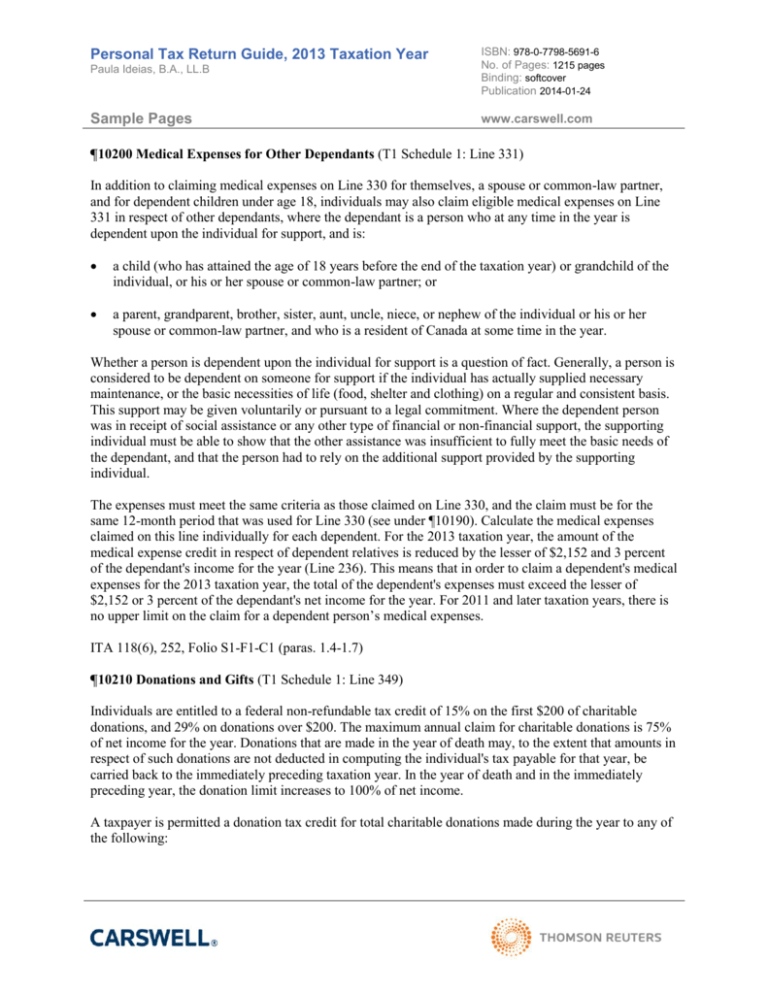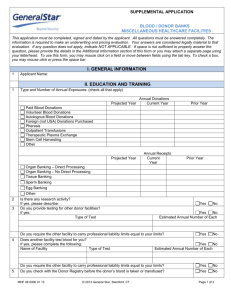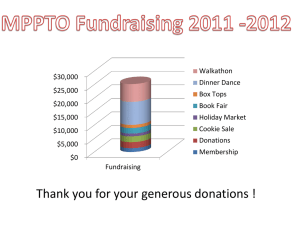Personal Tax Return Guide, 2013 Taxation Year Sample
advertisement

Paula Ideias, B.A., LL.B ISBN: 978-0-7798-5691-6 No. of Pages: 1215 pages Binding: softcover Publication 2014-01-24 Sample Pages www.carswell.com Personal Tax Return Guide, 2013 Taxation Year ¶10200 Medical Expenses for Other Dependants (T1 Schedule 1: Line 331) In addition to claiming medical expenses on Line 330 for themselves, a spouse or common-law partner, and for dependent children under age 18, individuals may also claim eligible medical expenses on Line 331 in respect of other dependants, where the dependant is a person who at any time in the year is dependent upon the individual for support, and is: a child (who has attained the age of 18 years before the end of the taxation year) or grandchild of the individual, or his or her spouse or common-law partner; or a parent, grandparent, brother, sister, aunt, uncle, niece, or nephew of the individual or his or her spouse or common-law partner, and who is a resident of Canada at some time in the year. Whether a person is dependent upon the individual for support is a question of fact. Generally, a person is considered to be dependent on someone for support if the individual has actually supplied necessary maintenance, or the basic necessities of life (food, shelter and clothing) on a regular and consistent basis. This support may be given voluntarily or pursuant to a legal commitment. Where the dependent person was in receipt of social assistance or any other type of financial or non-financial support, the supporting individual must be able to show that the other assistance was insufficient to fully meet the basic needs of the dependant, and that the person had to rely on the additional support provided by the supporting individual. The expenses must meet the same criteria as those claimed on Line 330, and the claim must be for the same 12-month period that was used for Line 330 (see under ¶10190). Calculate the medical expenses claimed on this line individually for each dependent. For the 2013 taxation year, the amount of the medical expense credit in respect of dependent relatives is reduced by the lesser of $2,152 and 3 percent of the dependant's income for the year (Line 236). This means that in order to claim a dependent's medical expenses for the 2013 taxation year, the total of the dependent's expenses must exceed the lesser of $2,152 or 3 percent of the dependant's net income for the year. For 2011 and later taxation years, there is no upper limit on the claim for a dependent person’s medical expenses. ITA 118(6), 252, Folio S1-F1-C1 (paras. 1.4-1.7) ¶10210 Donations and Gifts (T1 Schedule 1: Line 349) Individuals are entitled to a federal non-refundable tax credit of 15% on the first $200 of charitable donations, and 29% on donations over $200. The maximum annual claim for charitable donations is 75% of net income for the year. Donations that are made in the year of death may, to the extent that amounts in respect of such donations are not deducted in computing the individual's tax payable for that year, be carried back to the immediately preceding taxation year. In the year of death and in the immediately preceding year, the donation limit increases to 100% of net income. A taxpayer is permitted a donation tax credit for total charitable donations made during the year to any of the following: Paula Ideias, B.A., LL.B ISBN: 978-0-7798-5691-6 No. of Pages: 1215 pages Binding: softcover Publication 2014-01-24 Sample Pages www.carswell.com Personal Tax Return Guide, 2013 Taxation Year A registered Canadian charity (which includes Canadian resident charitable organizations, private foundations and public foundations), A registered Canadian amateur athletic association, A housing corporation that is exempt from tax under ITA 149(1)(i), A Canadian municipality, The United Nations and its related agencies, A prescribed foreign university whose student body ordinarily includes students from Canada (see ITR Schedule VIII), A charitable organization outside Canada to which the Government of Canada has made a gift in 2012 or 2013 (these organizations are identified by the CRA in Information Circulars from time to time; see IC 84-3R5, revised by a Special Release), and The Government of Canada, a province or territory. ¶10211 Calculation of Charitable Donation Tax Credit The credit available to an individual in determining tax payable in respect of total gifts made is computed by way of a formula in ITA 118.1(3): (A × B) × [C × (D – B)], where: A = 15 percent (the lowest tax rate for the year) B = the lesser of $200 and total gifts C = 29 percent (the highest tax rate for the year) D is the total gifts (as defined) for the year Under this formula, the individual's credit would be 15 percent of total gifts up to $200, and 29 percent of total gifts over $200. ¶10211.1 First-Time Donor’s Super Credit For donations made after March 20, 2013, qualifying first-time donors may be eligible to receive an additional federal tax credit of 25 percent on the first $1,000 of monetary donations, over and above the normal donation tax credit as calculated above. The first-time donor’s super credit can be claimed once from the 2013 to 2017 taxation years. Reproduced below is an excerpt from questions and answers released by the CRA on April 2, 2013 regarding the first-time donor’s super credit (see cra-arc.gc.ca/gncy/bdgt/2013/qa01-eng.html): Q1. How is the existing non-refundable tax credit for charitable donations calculated? A1. Currently, the non-refundable charitable donations tax credit (CDTC) is calculated as the total of: the lowest income tax rate (15% for 2013) multiplied by the first $200 of charitable donations claimed by an individual; and the highest income tax rate (29% for 2013) multiplied by the portion of the donations claimed by the individual that exceeds $200. Paula Ideias, B.A., LL.B ISBN: 978-0-7798-5691-6 No. of Pages: 1215 pages Binding: softcover Publication 2014-01-24 Sample Pages www.carswell.com Personal Tax Return Guide, 2013 Taxation Year Q2. What is the new First-Time Donor’s Super Credit (FDSC)? A2. Starting in the 2013 taxation year, the budget proposes to introduce a temporary nonrefundable FDSC that will supplement the CDTC for individuals [note that this proposal has now been legislated by Bill C-60]. This new credit effectively adds 25% to the rates used in the calculation of the CDTC for up to $1,000 of monetary donations. As a result, a first-time donor will be allowed a 40% federal credit for donations of $200 or less, and a 54% federal credit for the portion of donations over $200 but not exceeding $1,000. Example 1: An eligible first-time donor claims $500 of charitable donations in 2013. All of the donations are donations of money. The first-time donor’s FDSC and CDTC would be calculated as follows: First $200 of charitable donations claimed: $200 x 15% = $30 Charitable donations claimed in excess of $200: $300 x 29% = $87 First-Time Donor’s Super Credit: $500 x 25% = $125 Total FDSC and CDTC: $242 Example 2: An eligible first-time donor claims $700 of charitable donations in 2013. Only $300 of the donations are donations of money. The first-time donor’s FDSC and CDTC would be calculated as follows: First $200 of charitable donations claimed: $200 x 15% = $30 Charitable donations claimed in excess of $200: $500 x 29% = $145 First-Time Donor’s Super Credit: $300 x 25% = $75 Total FDSC and CDTC: $250 Q3. When can I claim the FDSC? A3. As the FDSC is a temporary credit, you can only claim it once from the 2013 to 2017 taxation years. Q4. Who is considered a first-time donor? A4. For the 2013 taxation year, an individual will be considered a first-time donor if neither the individual nor the individual’s spouse or common-law partner has claimed the CDTC in any of the five preceding tax years. Q5. Can both my spouse or common-law partner and I claim the FDSC? A5. As a first-time donor, the FDSC, along with the corresponding CDTC, may be shared by you and your spouse or common-law partner in a particular taxation year. However, the total amount of donations that may be claimed for the FDSC by both individuals cannot exceed $1,000. When it cannot be agreed on the amount of the credit that each of you will claim, the CRA may apportion the credit. Paula Ideias, B.A., LL.B ISBN: 978-0-7798-5691-6 No. of Pages: 1215 pages Binding: softcover Publication 2014-01-24 Sample Pages www.carswell.com Personal Tax Return Guide, 2013 Taxation Year Q6. Do all of my donations qualify for the FDSC? A6. No. Only donations of money that are made after March 20, 2013 will qualify for the FDSC. For taxation years from 2013 to 2017, a new Line will be added to Schedule 9, Donations and Gifts to identify the eligible portion of the charitable donations that you have claimed that are donations of money. ¶10211.2 Donation Carry-Forward The amount creditable in any year in respect of charitable donations is limited to the taxpayer's total gifts. However, charitable donations which are not claimed in a taxation year may be carried forward and claimed in the five immediately following years, as long as the sum of the amount carried forward to a subsequent year plus the amount of the taxpayer's charitable donations for that subsequent year does not exceed 75 percent of the taxpayer's income for that year. There is an ordering rule that requires tax credits in respect of gifts to be claimed in the order in which the gifts were made. This means that an individual may not claim the tax credit for a gift made in the current year until all credits in respect of gifts made in previous years have been claimed. ITA 118.1(1), 118.1(3) ¶10212 Meaning of a “Gift” ¶10212.1 Common Law The Courts have generally found that where consideration is received in respect of a transfer of property, the transfer does not constitute a gift even if there is a clear gift element and donative intent. In other words, to constitute a “gift”, the property transferred must be transferred voluntarily and without consideration – i.e., the “donor” cannot by way of return receive any advantage of a material character (see Woolner [2000] 1 C.T.C. 35 (FCA) and Zandstra [1974] C.T.C. 503 (FCTD)). In Tite [1986] 2 C.T.C. 2343, the Tax Court found that it was not possible to make a “gift” for purposes of the donation tax credit if some valuable consideration such as goods or services was received in return. Thus, a taxpayer who paid $450 to the Canadian Wildlife Federation to obtain a Robert Bateman print was not allowed the $250 deduction he claimed. The Court was not persuaded by the taxpayer's argument that the offer made by the Canadian Wildlife Federation should be treated in the same manner as those for the purchase of tickets for dinners, balls, concerts or shows, where official receipts are issued for part of the payment made. Noting that there was a contractual obligation to pay the $450, the Court considered that in this case no gift, in the proper sense, had been made. Further, the loan of property (including money) is not considered to be a gift for purposes of the donation tax credit.






